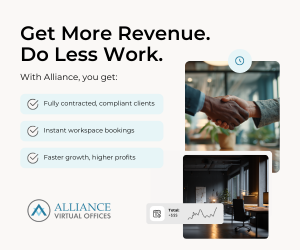- Flexible workspaces are transforming the office model, offering businesses agility and cost savings in a hybrid work environment.
- The “return to office” debate misses the point; it’s about managing employees in various environments to boost productivity.
- As AI and remote work reshape real estate, businesses need smaller, flexible spaces for collaboration, reducing traditional office costs.
The traditional office model is crumbling under the weight of outdated contracts and changing work habits, but the rise of flexible workspaces is giving businesses the agility they need to thrive in a hybrid world.
Those changing workforce needs are reshaping the way companies think about office space, with more and more organizations opting for flexible, scalable solutions.
Mark Dixon, founder and CEO of IWG, recently joined The Allwork.Space Future of Work® Podcast to discuss these commercial real estate industry shifts and how companies are adapting. Dixon has been a driving force behind the transformation of workspaces from static, traditional offices to flexible, adaptable environments.
With IWG’s global footprint of over 5,000 locations and partnerships with major Fortune 500 companies, Dixon’s perspective on the future of work offers valuable insights into how businesses can rethink real estate, workforce management, and the very concept of office space.
A Frustration That Sparked a Movement
Dixon’s story began with a frustrating encounter in the office leasing world. Having launched multiple businesses, he was no stranger to the challenges that came with long-term office leases. Faced with inflexible contracts and inadequate workspaces, Dixon saw an opportunity to create something better. The idea wasn’t about simply improving the office model, but offering businesses and freelancers the flexibility to adapt to a variety of needs.
In Brussels, where Dixon was based, he witnessed professionals working out of cafes and makeshift spaces, simply because they lacked suitable meeting rooms. This experience led him to build what would become IWG—a company aimed at creating spaces that catered to the actual needs of workers, not just the real estate industry.
The “Return to Office” Question: A Misleading Debate
One of the most hotly debated topics in today’s business environment is the so-called “return to office” (RTO) movement. Many executives and media outlets continue to ask whether offices will return to full capacity, as if there’s one clear answer.
Dixon argues that this framing is misleading.
The question isn’t whether offices will make a comeback, but how they’ll function in the modern workforce. While companies still believe that office environments serve a purpose, such as supporting focus, many are questioning whether it’s worth forcing employees to commute when that time could be spent more productively elsewhere.
“It makes no sense in the digital world to have people commuting hours a day to go and use a laptop somewhere else,” he said.
For Dixon, the future is about managing employees effectively across a mix of environments. Companies need to focus on finding ways to improve the work conditions for their teams, whether that means offering them a comfortable, productive workspace at home, in the office, or in a hybrid setup.
He highlights that, at the core, it’s about boosting productivity by providing workers with the best environments and tools, not enforcing an office-first mentality.
The Role of AI and Remote Work in Real Estate Economics
A surprising element of Dixon’s vision is how technology is transforming the very foundation of the real estate market. AI’s impact on work processes will likely reduce the need for office space altogether, especially for back-office operations, where automation can handle a significant portion of tasks. Dixon predicts that AI will play a major role in reducing the demand for traditional office spaces, as businesses can rely on digital infrastructure and remote work instead of maintaining expensive real estate.
This doesn’t mean that office spaces are obsolete, though. It’s more about reducing the real estate footprint while making remaining office environments more appealing. As businesses become increasingly efficient, the demand for flexible workspaces will rise. What companies will need are smaller, better-located spaces where employees can meet and collaborate, not sprawling office parks. For Dixon, this is a practical shift to align real estate use with the digital age, where productivity doesn’t require physical proximity.
Rethinking Office Space: Quality Over Quantity
The future of office spaces, according to Dixon, will focus on providing employees with high-quality, well-located, and flexible spaces that are easy to access and offer the right environment for productive work.
“Clearly there’s a huge job for offices in helping individuals be more productive for their company. Equally, there will be people that are really good at working from home, and there’s no problem as long as you can manage it,” Dixon said during our conversation.
The days of sprawling office complexes that serve as the hub of every business operation are numbered. Moving forward, businesses will rely on a network of interconnected locations, creating flexibility for workers and saving on the high costs associated with traditional leases.
Instead of one massive headquarters, companies will tap into an extensive network of spaces that allow workers to choose a convenient, high-quality location for collaboration. It’s necessary to provide workers with options that suit their needs—whether they need a place to focus, meet with colleagues, or take a break from working from home. The key to success is offering flexibility without compromising on the quality of the workspace itself.
The Economic Factor: Making Office Space Work for Business
The rise of flexible workspaces is driven largely by economic considerations. Businesses have realized that offering flexible workspaces, both remote and in-office, can drastically cut costs without sacrificing productivity. By reducing the overhead costs tied to maintaining large office spaces, companies can reallocate resources to more efficient operations. Flexible workspaces attract people not only for convenience but also for their financial advantages.
For businesses, the decision to move away from long-term office leases and invest in flexible spaces often boils down to one factor: efficiency.
HR departments are finding it easier to hire employees from a broader geographic area, and companies are discovering that not all roles require a fixed office. Flexibility goes beyond employee freedom; it gives businesses an agile infrastructure to grow while cutting costs.
The Road Ahead: More Locations, More Flexibility
Looking to the future, Dixon’s strategy for IWG is clear: more locations, more options, and more flexibility. As companies realize the financial and operational benefits of flexible workspaces, demand will continue to rise. IWG is not stopping at its current 5,000 locations—Dixon expects to expand that number significantly, with hundreds of new locations planned across the globe. In a world where change is the only constant, flexibility in the workplace is the future of work.


 Dr. Gleb Tsipursky – The Office Whisperer
Dr. Gleb Tsipursky – The Office Whisperer Nirit Cohen – WorkFutures
Nirit Cohen – WorkFutures Angela Howard – Culture Expert
Angela Howard – Culture Expert Drew Jones – Design & Innovation
Drew Jones – Design & Innovation Jonathan Price – CRE & Flex Expert
Jonathan Price – CRE & Flex Expert












